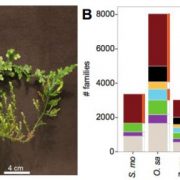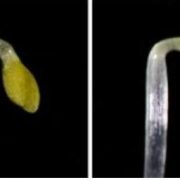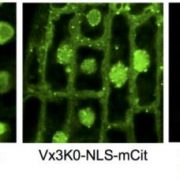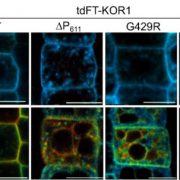
Know Your Roots: A Transcriptomic Exploration of Key Life History Traits in the Model Lycophyte Selaginella moellendorffii
Research, The Plant Cell, The Plant Cell: In BriefLand plants (embryophytes) evolved from a freshwater charophycean algal predecessor over 450 million years ago and have since separated into the diversity of plant lineages observed today. A key factor in the expansion of plant life on land was the evolution of rooting structures and a vasculature that…

Hormonal Solution for (Root) Hair Extension
Research, The Plant Cell, The Plant Cell: In BriefRoot hairs are tubular outgrowths of a subset of root epidermal cells serving multiple roles, including plant anchorage in the soil, water and nutrient absorption, and symbiotic interactions with nitrogen fixing bacteria in legumes (Salazar-Henao et al., 2016). Root hairs form an interface between the…

Open Sesame! Uncovering a Hidden Key Used by Pathogenic Bacteria to Open the Doors Connecting Plant Cells
Research, The Plant Cell, The Plant Cell: In BriefIt has been known for several decades, and suggested as early as the 1930s (Caldwell 1931), that viruses move their proteins and other molecules from one plant cell to the next by altering and regulating plasmodesmata (PD), the tiny doors connecting the cytoplasm between plant cells. And only in the…

Collinear Chromosomes and Shifting Centromeres in the Arabideae
Research, The Plant Cell, The Plant Cell: In BriefFor such an important structure, the centromere certainly is hard to pin down, particularly in regard to the relationship between its sequence composition and epigenetic state and its functions in chromosome pairing and kinetochore formation. In addition to undergoing rapid sequence evolution, centromeres…

Ethylene vs. Salicylic Acid in Apical Hook Formation
Research, The Plant Cell: In BriefWhen seeds germinate underground, the emerging seedlings must push upward through the soil to reach sunlight and begin photoautotrophic growth. As the hypocotyl emerges from the seed, mechanical pressure against the soil induces production of ethylene, which accumulates and promotes hypocotyl curling.…

Ubiquitous ubiquitin: The K63 ubiquitinome
Research, The Plant Cell: In BriefPolyubiquitination, the sequential attachment of the small 8kDa globular protein ubiquitin (Ub) to target proteins, represents a major post-translational modification that ultimately determines the substrate’s cellular fate. Ub conjugation is an extremely versatile form of protein regulation since…

Make, Modify, Move: Multilayered Regulation of ONAC054 During ABA-Induced Leaf Senescence
Research, The Plant Cell, The Plant Cell: In Brief‘Senescence’ originates from the Latin word senescere, to grow old. However, the process of leaf senescence is not simply the passive death of the leaf but instead represents an active and highly regulated process of nutrient remobilization from older leaves into developing parts of the plant to…

Journey and destination: KORRIGAN1 subcellular localization dynamically changes during plant growth and stress tolerance
Research, The Plant Cell: In BriefNumerous proteins coordinate the synthesis, delivery, and assembly of cell wall components during cell wall biosynthesis (McFarlane et al., 2014). KORRIGAN1 (KOR1) is a membrane-anchored endo-β1,4-glucanase glycoprotein involved in the cellulose biosynthesis of primary and secondary cell walls. KOR1…

To Be or Not To Be Pathogenic: Transcriptional Reprogramming Dictates a Fungal Pathogen’s Response to Different Hosts
Research, The Plant Cell, The Plant Cell: In BriefThe fungal pathogen Fusarium virguliforme invades a wide spectrum of host plants, ranging from eudicots to monocots. Interestingly, fungal root colonization results in disease-producing phenotypes only in certain eudicot hosts (Kolander et al., 2012). For instance, F. virguliforme causes sudden death…

